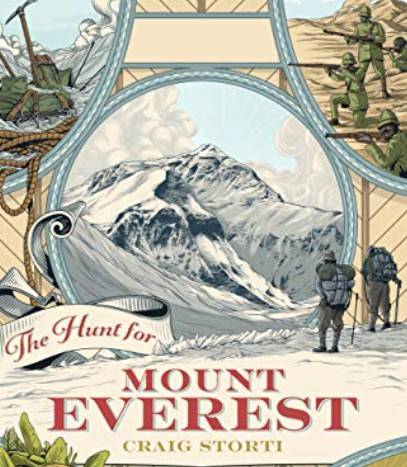My review of ‘The Hunt for Mount Everest’ by Craig Storti
Published in Literary Review
December 2021
My great-uncle’s string vest hangs in an inn in Snowdonia. It is displayed in a cabinet in the Pen-y-Gwryd Hotel, along with ropes, a woolly hat, a tin mug, crampons, an umbrella and other memorabilia from the 1953 Everest expedition, of which the wearer of that vest, John Hunt, was the leader. These holy relics of alpinism loomed large in my childhood, as did my great-uncle’s tales of mysterious footprints in the snow and yeti howls carried on the wind. That iconic climb, when Edmund Hillary and Tenzing Norgay planted the Union Jack on top of the highest mountain on Earth, formed a semi-mythologised backdrop to the burgeoning of my own desire for adventure.
The story of Mount Everest is often told as though it ended there, with the first successful ‘conquest’ of 29 May 1953, and began only three decades before, with the 1921 British reconnaissance expedition (the members of which included the doomed George Mallory). In The Hunt for Mount Everest, Craig Storti approaches the world’s highest mountain from several very different angles, ending his account at the point where most others start. The book reaches back to the first recorded instance of recreational ‘climbing’ in the Alps in 1741 to tell the story of what had to happen before an ascent could be attempted, or even conceived of. Only once the idea of climbing tall rocks for the sake of it had come into existence, and special equipment and techniques been developed, could vertical adventurers look to the peaks of other ranges.
But the Himalayas would not have been breached had it not been for British imperialism. Storti takes a two-pronged approach to this aspect of the Everest story. The first chapter of the book recounts the extraordinary endeavours of the Great Trigonometrical Survey of India, which meticulously charted the length and breadth of the Indian subcontinent, from its sweltering southernmost tip to the misty uplands of Darjeeling. From there, in 1850, the surveyors glimpsed a distant ‘blot on the horizon’, which at first they simply called Peak XV; it took another seventy-one years from that initial mirage-like sighting for any Westerner to get within forty miles of it. Astonishingly for something so large, Everest proved rather hard to find. ‘Because it’s there,’ Mallory famously said when asked why he wanted to climb it, but for rather a long time no one was sure that it was.
Seeing it was one thing, but getting there was another. Everest’s inaccessibility was due not only to the fearsome challenges posed by topography, but to geopolitics as well: situated between Nepal and Tibet, and therefore beyond British reach, it was also sandwiched between two rival empires. The third chapter plunges into the machinations of the Great Game, in which Britain, obsessed by the fear that an expanding Russia might one day threaten India, found itself drawn ever deeper into Central Asia.This mission creep led to the disasters of the Anglo-Afghan wars and to Francis Younghusband’s 1904 incursion into Tibet, which saw up to seven hundred Tibetans slaughtered by machine-gun fire in what has become known as the Massacre of Chumik Shenko. Storti calls it ‘one of the most shameful episodes in British imperial history’.
‘It was nothing but pure butchery,’ its architect wrote afterwards. ‘I have had an absolutely miserable day.’ This same Younghusband, later elected president of the Royal Geographical Society, appears again at the end of the book, writing in 1921: ‘The doom of Everest is sealed … Everest fights stoutly with her many terrible weapons, but she fights blindly … She cannot learn from experience … This doom can be seen to be relentlessly closing in on Everest.’ The triumphalist bombast of these words highlights the uncomfortable link between the assaulting and conquering of mountains and the assaulting and conquering of peoples. The story of Everest, which takes its name from a colonial official, is inextricably bound up with the story of empire: without the bloody exploits of Younghusband and others like him, its summit would have remained untrodden for much longer.
But Storti also introduces us to a cast of other characters, each of whom in his own way (there are very few women in the book) brought the first successful ascent of the mountain within reach: the surveyor Cecil Rawling, who mapped vast swathes of Tibet; the chemist Alexander Kellas, whose studies in barometric pressure and oxygen absorption helped to facilitate high-altitude climbing; and the cinematographer John Noel, ‘a highly successful hustler, self-promoter and a determined, infamous entrepreneur’, who sneaked into Tibet in disguise to get closer to Everest’s base than any Westerner had done before. The only thing that feels missing from Storti’s account is the role of the Sherpas, without whom surely no ascent would have been possible. That the narrative is weighted towards British rather than local perspectives is perhaps inevitable, seeing as how the Nepalese and Tibetans, untouched by the fever of alpinism, never showed the slightest interest in trying to scramble to the summit of what was (and still is) for them a holy mountain.
Storti tactically circles his subject, delaying the reader from getting too close until all the approaches are covered. Each chapter moves us incrementally higher, from one plateau to the next. Storti does an admirable job of guiding us up the slopes and is an enjoyable companion. Next time I visit my great-uncle’s vest, I will remember the centuries-long story of how it got there.


